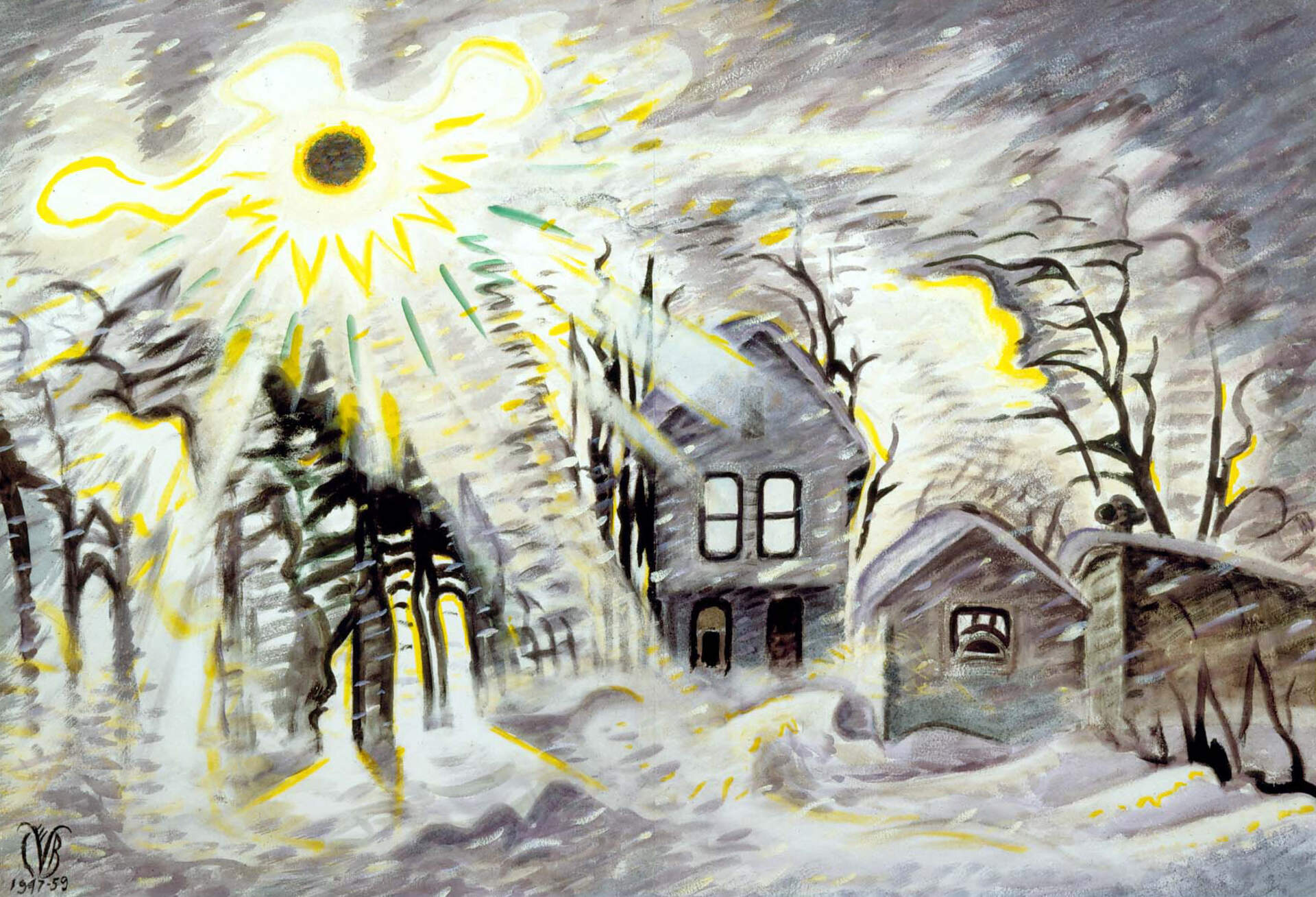
Charles E. Burchfield (1893-1967), Sunshine During a Blizzard, 1947-1959; watercolor on paper, 30 1/2 x 40 1/2 inches; Image from the Burchfield Penney Archives
Finding Happiness in a Blizzard by Philip Koch
Friday, Feb 22, 2013
Finding Hapiness in a Blizzard by Philip Koch
Read more at http://philipkochpaintings.blogspot.com/2013/02/finding-happiness-in-bllzzard.html
This painting by Charles Burchfield (American, 1893-1967) is one of those paintings that should look superficial and a bit ridiculous but instead holds up as serious art. To me "serious art" just means something you're going to want to look at more than once. In this case I'd like to look quite often.
What is Burchfield painting? In a heavy snow sometimes the clouds part for a moment and shafts of sunlight pierce through the airborne falling snow. The air fills with thousands of improbable tiny drifting diamonds. One doesn't see it very often, but if you've lived in the snow belt in Western New York State (as Burchfield and I did) you've seen it more often. You'd have to be made of stone not to be moved by it. I don't think we have words adequate to describe the sensation.
Burchfield was making a painting about his inner experience of something he'd seen. That he was such a good painter allowed him to make something that could reach out and stir some of those same feelings in complete strangers. In that way it's remarkable.
Much of what makes this watercolor work is that Burchfield adds an unanticipated supporting cast to build a tableau to support his story. There's a whole extra element added by the sharply drawn rhythms of the pointy tree branches and the three quite solid houses.
It's a challenge to paint sunlight and give it the feeling of weight and impact it deserves. Burchfield paints his rays of sun as if they're solid enough to cover over and block us momentarily from seeing his grove of trees and the wood siding on his tallest house. I think many lesser painters would have been tempted to overdo it with the sunlight and have it completely dominate the scene.
Instead, Burchfield relegates his yellows to pretty much just the left hand side of the painting, and gives the neutral grays of snowy sky, drifts on the ground, and the all-gray houses much more of the surface of his painting. In a way the artist is walking a tightrope between snowy dreariness and golden exuberance. And he demonstrates an exquisite sense of balance.
Burchfield invented a deeply personal shorthand for his mark making. They're part calligraphy and part just little bursts of abstract energy. I think it fascinating that Burchfield maintained a long term friendship with Edward Hopper (a painter I'm stylistically much closer too). Despite Hopper's legendary reluctance to find much worth in the work of his contemporaries, he did admire Burchfield's work. It's a tribute to the quality of Burchfield's expression that he could move someone as steadfastly focused on his own painter's direction as Hopper.
That's what I love about painting. It's a language to share some of our most powerful yet hard to express emotions with others. Most of the people who see Burchfield's paintings will never have met the man in person, yet in another way, they know him well. That's a kind of magic we need more of in this world. That's what motivates me to keep picking up my brushes and heading back to my easel.
About Philip Koch
Maryland-based artist Philip Koch (pronounced like "watch") has explored landscape painting for four decades.
Early on Philip Koch was inspired by the color and energy of modern art. Through his paintings he casts his modernist influenced eye back on the long tradition of American landsape panoramas from the 19th century. Based in Baltimore, he travels frequently to New England and upstate New York to paint in the same locations that inspired Edward Hopper, Winslow Homer, and the Hudson River School artists he admires. "Each generation" says Koch "needs a new image of what our earth looks like in our time. There will always be a need for landscape painters to show us where we live."
Koch is the great grandson of John Wallace, a Scottish landscape painter, and the grandson of John Capstaff, the inventor of the first commercially available color film, Kodachrome. Despite his family link to photography, Koch is committed to working from only direct observation or from memory rather than painting from photographs.
"There's a mysterious extra dimension that comes when you take your easel out into the field. To paint well you have to hear the wind rustle through the trees.
We all came from nature. When we give her our sustained attention, she in turn allows us to reach the most emotionally resonant place within ourselves. My job as a painter is to reach that place and make paintings to share it with others."
Learn more at ww.philipkoch.org